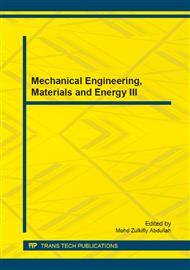[1]
E.P. Sakonidou, T.D. Karapantsios, A.I. Balouktsis, D. Chassapis., 2007. Modeling of the optimum tilt of a solar chimney for a maximum air flow. Science Direct, Solar energy 82 (2008) 80-94.
DOI: 10.1016/j.solener.2007.03.001
Google Scholar
[2]
M. Najmi, A. Nazari, H. Mansouri, G. Zahedi., 2011. Feasibility study on optimization of a typical solar chimney power plant. Heat Mass transfer (2012) 48: 475-485. Springer-Verlag (2011).
DOI: 10.1007/s00231-011-0894-5
Google Scholar
[3]
N.K. Bansal, R. Mathur, M.S. Bhandari. 1994. A study of solar chimney assisted wind tower system for natural ventilation in buildings. Building and Environment, Vol. 29, No 4. Pp. 495 500.
DOI: 10.1016/0360-1323(94)90008-6
Google Scholar
[4]
A. Li, P. Jones, P. Zhao, L. Wang. 2004. Heat transfer and natural ventilation airflow rates from single-sided heated solar chimney for buildings. JAABE vol. 3 no. 2 Nov. (2004).
DOI: 10.3130/jaabe.3.233
Google Scholar
[5]
N.K. Bansal, R. Mathur, M.S. Bhandari. 1993. Solar chimney for enhanced stack ventilation. Building and Environment, Vol. 28. No. 3 pp.373-377. G.
DOI: 10.1016/0360-1323(93)90042-2
Google Scholar
[6]
Evans, R. Greif, 1996. Buoyant instabilities in downward flow in a symmetrically heated vertical channel. PII: S0017-9310(96)00271-2. Elsevier science Ltd.
DOI: 10.2172/417001
Google Scholar
[7]
M. Fossa, C. Menezo, E. Leonardi., 2007. Experimental natural convection on a vertical surfaces for building integrated photovoltaic (BIPV) applications. Science Direct, Experimental Thermal and Fluid Science 32(2008) 980-990.
DOI: 10.1016/j.expthermflusci.2007.11.004
Google Scholar
[8]
E. Bacharoudis, M.G. Vrachopoulos, M.K. Koukou, D. Margaris, A.E. Filios, S.A. Mavrommatis. Study of the natural convection phenomena inside a wall solar chimneywith one wall adiabatic and one wall under a heat flux, Applied Thermal Engineering (2007).
DOI: 10.1016/j.applthermaleng.2007.01.021
Google Scholar
[9]
Tsai-Shou Chang., 2006. Effects of a finite section with linerarly varying wall temperature on mixed convection in a vertical channel. Science Direct, International Journal of Heat and Mass transfer 50(2007)2346-2354.
DOI: 10.1016/j.ijheatmasstransfer.2006.10.042
Google Scholar
[10]
G.E. Lau, G.H. Yeoh, V. Timchenko, J.A. Reizes., 2012. Numerical investigation of passive cooling in open vertical channels. Applied Thermal Engineering 39 (2012) 121-131, SciVerse Science Direct.
DOI: 10.1016/j.applthermaleng.2012.01.001
Google Scholar
[11]
D. Wenting, Y. Hasemi, Y. Minegishi. 2002. Model experiment and CFD Analysis on a solar assisted ventilation system. JAABE vol. 1 no. 2 November (2002).
Google Scholar
[12]
Songhao Wang, Chih Sheng, Huannming Chou, Edgar J. Tobias Corado, 2013, A Study of Solar Panel Chimney for House Ventilation, Applied Mechanics and Materials, Vol 422, pp.118-122.
DOI: 10.4028/www.scientific.net/amm.422.118
Google Scholar


